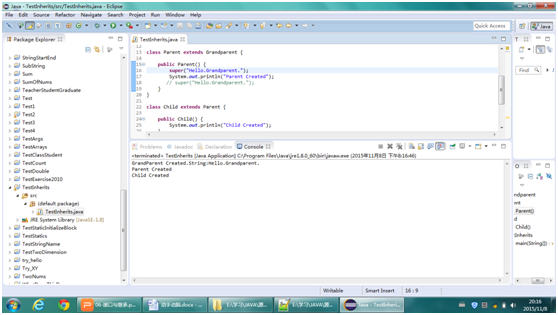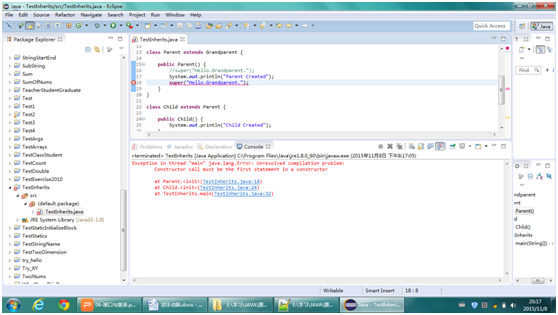一、继承条件下的构造方法调用
运行 TestInherits.java 示例,观察输出,注意总结父类与子类之间构造方法的调用关系修改Parent构造方法的代码,显式调用GrandParent的另一个构造函数,注意这句调用代码是否是第一句,影响重大!
1) 源代码
class Grandparent {
public Grandparent() {
System.out.println("GrandParent Created.");
}
public Grandparent(String string) {
System.out.println("GrandParent Created.String:" + string);
}
}
class Parent extends Grandparent {
public Parent() {
//super("Hello.Grandparent.");
System.out.println("Parent Created");
// super("Hello.Grandparent.");
}
}
class Child extends Parent {
public Child() {
System.out.println("Child Created");
}
}
public class TestInherits {
public static void main(String args[]) {
Child c = new Child();
}
}
2)运行结果截图



3)结论
通过 super 调用基类构造方法,必须是子类构造方法中的第一个语句。
一、参看ExplorationJDKSource.java示例
1) 源代码
public class ExplorationJDKSource {
/**
* @param args
*/
public static void main(String[] args) {
System.out.println(new A());
}
}
class A{}
2) 运行结果截图

3)结论
前面示例中,main方法实际上调用的是:
public void println(Object x),这一方法内部调用了String类的valueOf方法。
valueOf方法内部又调用Object.toString方法:
public String toString() {
return getClass().getName() +"@" +
Integer.toHexString(hashCode());
}
hashCode方法是本地方法,由JVM设计者实现:
public native int hashCode();